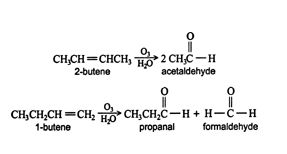Alkenes: Oxidation and Cleavage Reactions
Alkenes can easily be oxidized by potassium permanganate and other oxidizing agents. What products form depend on the reaction conditions. At cold temperatures with low concentrations of oxidizing reagents, alkenes tend to form glycols.

This reaction is sometimes referred to as the Baeyer test. Because potassium permanganate, which is purple, is reduced to manganese dioxide, which is a brown precipitate, any water‐soluble compound that produces this color change when added to cold potassium permanganate must possess double or triple bonds. This reaction involves syn addition, leading to a cis‐glycol (a vicinal dihydroxy compound). A cis‐glycol can also be produced by reacting the alkene with osmium tetroxide, OsO 4.
When more concentrated solutions of potassium permanganate and higher temperatures are employed, the glycol is further oxidized, leading to the formation of a mixture of ketones and carboxylic acids. ![]()

Oxidation of alkenes by ozone leads to destruction of both the σ and π bonds of the double‐bond system. This cleavage of an alkene double bond, generally accomplished in good yield, is called ozonolysis. The products of ozonolysis are aldehydes and ketones. ![]()

This reaction is often used to find the double bond in an alkene molecule. For example, the isomers of C 4H 8 can be distinguished from one another via oxidative cleavage. ![]()

By identifying the products of the reaction, one isomer can be distinguished from another, and the position of the bonds in the original compound can be determined.